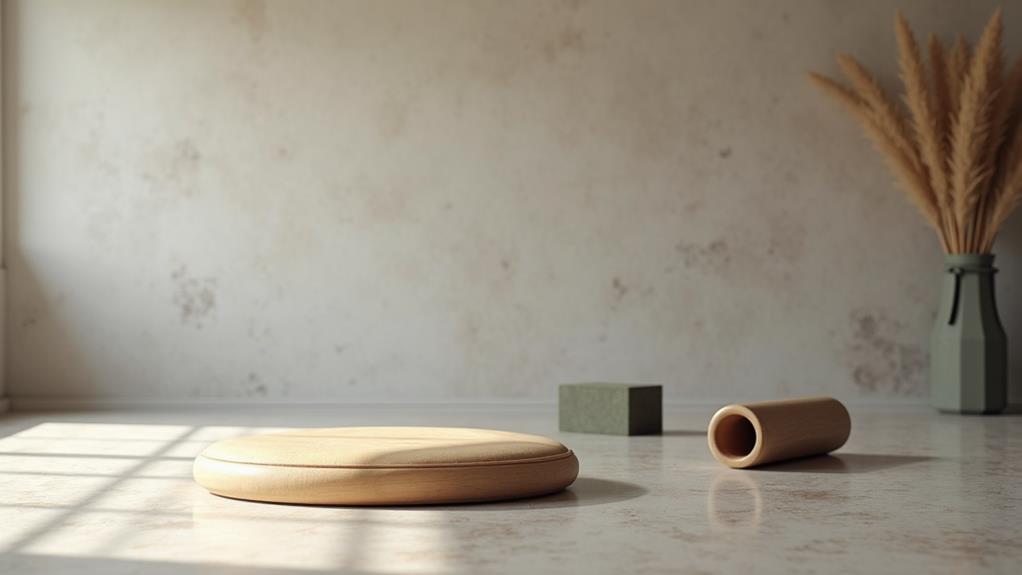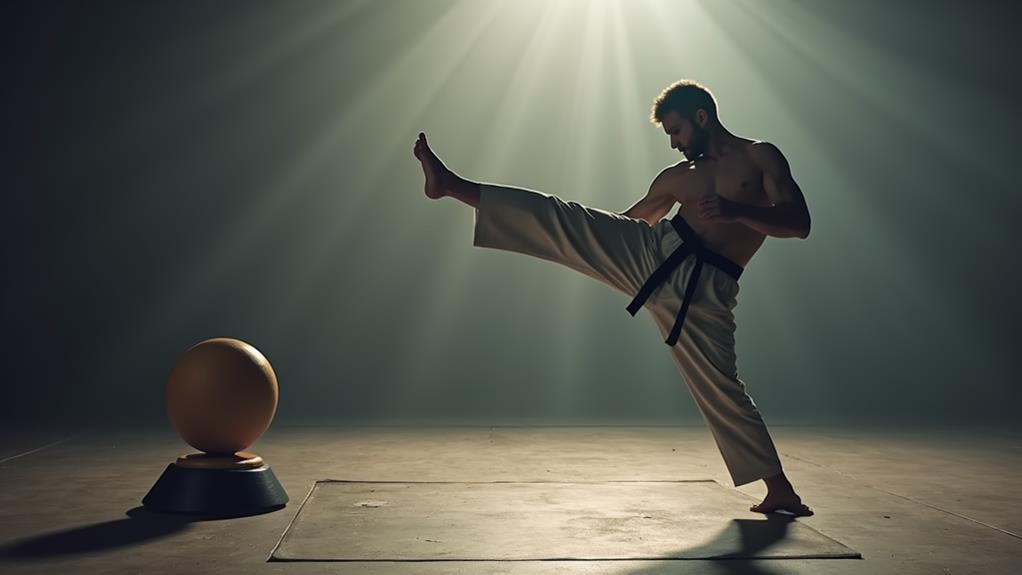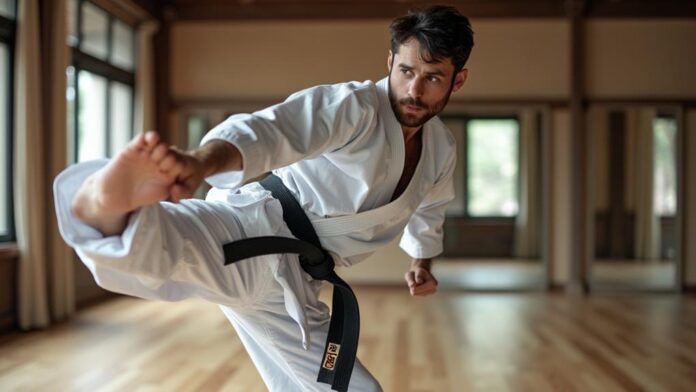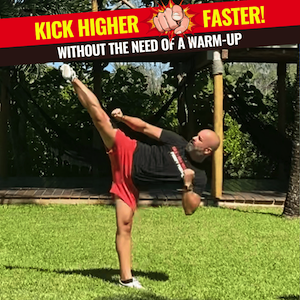You can master powerful kicks despite limited flexibility by modifying your technique. Focus on hip movement, strength, and control rather than leg height. Try modified roundhouse kicks that target lower angles, front kicks that emphasize hip movement, and short extension side kicks that prioritize form over height. Gradually increase your kick height over time to build confidence and flexibility. By adapting your kicks to your current flexibility level, you'll reduce your risk of injury and improve your overall technique. As you explore these modified kicks, you'll discover how to harness your unique strengths and take your martial arts skills to the next level.
Modified Roundhouse Kicks for Power
The modified roundhouse kick offers a powerful alternative for martial artists who struggle with high kicks. You can generate significant power by pivoting your supporting foot and rotating your hip, even with a lower chambering position. Focus on proper technique and use a shorter range of motion to deliver effective strikes, especially when targeting your opponent's lower body.
Incorporating dynamic stretching into your training can improve your flexibility over time. Even with modified kicks, gradually increasing your range of motion can make a difference in your performance. Start by targeting your hip and groin areas to enhance your kick's effectiveness.
For increased power and technique, train with a resistance band. This tool helps build your strength without requiring extreme flexibility. As you progress with strength training, your modified roundhouse kicks become even more potent.
Regular resistance band practice guarantees your techniques remain sharp, providing the best possible outcome. Improve your modified roundhouse kicks by combining dynamic stretching with resistance band training to get the most out of each strike.
Front Kicks for Hip Movement
By focusing on front kicks, you can improve your hip movement and build strength in your lower body, even with limited flexibility. Front kicks primarily engage your hip flexors and quadriceps, making them an effective choice for building strength and improving hip movement gradually. To get the most out of your front kicks, emphasize proper hip rotation, which enhances kick height and power by maximizing the use of your hip joint's range of motion.
| Training Method | Benefits | Tips |
|---|---|---|
| Varying kick heights | Adapts hip movement, reduces injury risk | Start low, increase height gradually |
| Resistance band training | Enhances strength and flexibility | Use bands with front kicks for added resistance |
| Targeted hip stretching | Improves flexibility, enables higher kicks | Focus on hip flexors and quadriceps |
| Regular front kick practice | Builds strength, improves hip movement | Aim for 2-3 times a week, 10-15 reps |
| Combining front kicks with stretching | Increments flexibility, enhances kick effectiveness | Stretch after kicking, focus on hip flexors |
Short Extension Side Kicks

Frequently used in martial arts training, short extension side kicks offer a modified kicking technique that's easy to master, even for those with limited flexibility. This technique involves executing the kick at a lower height, focusing on control and proper form rather than maximum flexibility. By doing so, you emphasize using your hip and core muscles to generate power and maintain stability.
As you practice short extension side kicks, you improve muscle strength in your hips and legs, which is essential for gradually increasing flexibility over time. You can practice the kick with a target at waist height, helping you develop accuracy and precision while reducing the risk of injury associated with high kicks.
Incorporating short extension side kicks into your training routines enhances your overall kicking ability and serves as a foundation for more advanced kicking techniques as your flexibility improves. By mastering short extension side kicks, you develop a strong foundation in kicking techniques.
Gradual Progression for Confidence
Martial artists with limited flexibility often struggle to master kicking techniques, but gradual progression can be a game-changer. By starting with modified kicks that focus on form rather than height, you'll feel more secure in your abilities and begin to see tangible improvements over time.
As you incorporate dynamic stretches and strengthening exercises regularly, you'll enhance your flexibility progressively, enabling you to kick higher without discomfort.
To achieve this, set small, achievable goals, such as increasing kick height by an inch each week. This will foster a sense of accomplishment and motivate further practice.
You'll be targeting specific muscle groups, including your hips, legs, and lower back, to improve flexibility and strength. By celebrating each milestone, no matter how small, you'll reinforce positive progress and encourage continued commitment to improvement in kicking techniques.
As you continue with gradual progression, you'll develop the confidence to tackle more complex kicking techniques and see real improvement in your skills. With patience and consistent practice, you'll master kicks that previously seemed impossible.
Building Flexibility Over Time

As you shift your focus to building flexibility over time, you'll start to see tangible improvements in your kicking techniques. To achieve this, you'll need to commit to consistent practice of targeted stretches and exercises. The wide horse stance and front leg stretches are excellent for improving hip and leg flexibility, crucial for effective kicking.
Incorporate dynamic stretching techniques, such as leg swings and high knees, into your warm-up routines to enhance flexibility and prepare your body for martial arts training.
Gradually progress in your stretching routines by slowly increasing the height of leg support. This will help you safely improve flexibility without risking injury. Regularly practicing PNF stretching can deepen stretches and enhance flexibility more effectively than static stretches alone.
As a martial artist, it's important to monitor your progress and adjust your flexibility routines based on your individual needs. By doing so, you'll achieve long-term improvements in your flexibility and kicking performance.
With dedication and patience, you'll be able to execute kicks with greater ease, power, and precision, taking your martial arts training to the next level.
Effective Kicking Techniques for Control
Take control of your kicking technique by focusing on a strong base, which begins with a stable stance. This foundation allows for better control and reduces the risk of injury, even if you have limited flexibility.
To build this base, incorporate exercises like controlled leg swings and low kicks into your practice routine. These movements enhance muscle memory and improve overall kicking technique, all without requiring extreme flexibility.
As you work on your technique, focus on modified kicks like the side kick and front kick, which deliver effective power and precision with less hip flexibility. You won't need to master the front split to execute these kicks.
Instead, concentrate on proper hip rotation during each kick. This will compensate for limited leg height and make your strikes more effective.
Adapting Kicks for Reduced Flexibility

You've worked on building a strong foundation and mastering modified kicks, but what happens when reduced flexibility holds you back? Don't worry, you can still adapt your kicks to accommodate your limitations. By modifying kicks to focus on lower heights, you can maintain control while minimizing strain on your leg muscles. For example, practice front kicks and side kicks with a bent knee to reduce the required range of motion.
To improve your flexibility over time, incorporate dynamic stretching before practicing kicks. This will enhance your range of motion in a controlled manner, reducing the risk of injury. You can also use resistance bands during kick practice to build strength and improve flexibility gradually.
Focus on proper hip rotation and body alignment to compensate for reduced flexibility, ensuring effective technique without requiring full extension. Regularly performing specific flexibility exercises, such as the wide horse stance and side stretches, can also help improve your overall flexibility and kick height, even with initial limitations.



